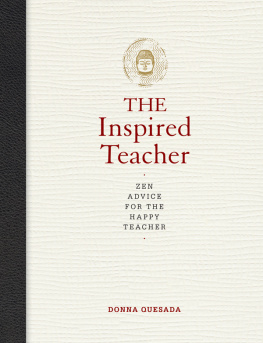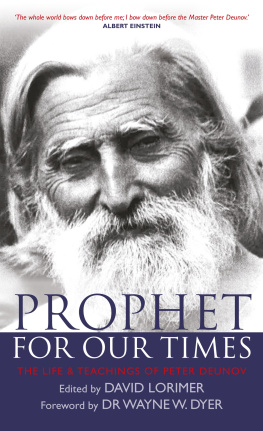Copyright 2016 by Donna Quesada
Originally published by Skyhorse Publishing, Inc. as The Buddha in the Classroom by Donna Quesada, 2011.
All Rights Reserved. No part of this book may be reproduced in any manner without the express written consent of the publisher, except in the case of brief excerpts in critical reviews or articles. All inquiries should be addressed to Skyhorse Publishing, 307 West 36th Street, 11th Floor, New York, NY 10018.
Skyhorse Publishing books may be purchased in bulk at special discounts for sales promotion, corporate gifts, fund-raising, or educational purposes. Special editions can also be created to specifications. For details, contact the Special Sales Department, Skyhorse Publishing, 307 West 36th Street, 11th Floor, New York, NY 10018 or .
Skyhorse and Skyhorse Publishing are registered trademarks of Skyhorse Publishing, Inc., a Delaware corporation.
www.skyhorsepublishing.com
10 9 8 7 6 5 4 3 2 1
Library of Congress Cataloging-in-Publication Data is available on file.
Cover design by Brian Peterson
Print ISBN: 978-1-63220-341-0
Ebook ISBN: 978-1-63220-838-5
Printed in China
CONTENTS


Preface
T hough I have changed the names to protect the identity of my students, the stories in this book are true and are woven into a collection of chapters that may be read chronologically or randomly. These anecdotes are set in the context of a community college, but teachers of every level will identify with the conundrums recounted therein, which are universal to all classrooms.
Most of the events in this book took place during the course of a particularly trying semester, from the familiar first-day ride to campus right through to the end of the course, with its inevitable barrage of emailed grade complaints. I was in a lecture hall with 125 students, where the discord I felt with this group was both worsened by and pivotal in magnifying my already growing feelings of burnout.
Turning to my longtime spiritual practice, I survived that semester and gradually rediscovered the joy that had been progressively declining. It is my wish to take you along with me on what Ill call a spiritual journey and to share with you some of the insights I have learned through my formal training in Zen Buddhism, as well as through my longtime practicesboth as a teacher and a discipleof classical Yoga.
Each chapter concludes with an essential dharma teaching, relevant to the quandary presented. Dharma, in its most basic sense, is the word for Buddhas teachings, and although I am presenting what I hope will be viable lessons for you in these sections, The Inspired Teacher is not a how-to book for teachers; rather, it is an intimate portrayal of the often-paradoxical Zen wisdom pertinent to the anecdote. It explores, in the context of unique sketches, my frustrations as a teacher and the lessons I took away from various situations. They are the lessons that would bring me back and that would reveal, time and again, that no matter the situation, its always about getting your head in the right place first. Resolution starts in our own minds.
The Zen wisdom that concludes each chapter contains the fruits of Buddhas insight, as an enlightened being. He wasnt a god. He was someone who found a way out of his own suffering and dedicated the rest of his life to helping others escape theirs. Pain, loss, and everyday grievances are inevitable, but he showed us how to unshackle ourselves from the additional suffering we habitually bring upon ourselves in the form of mental anguish. To escape this suffering is to wake up. It is to wake up to our own inherent wisdom and to an abiding sense of serenity and equanimity. It is to wake up to that inner light within that rouses our feeling of connection and enthusiasm in all that we do.
Some days, some semesters, and perhaps even some years will be more challenging and more wearisome than others. But my wish is that you find within this series of classroom vignettes a lasting source of encouragement and inspiration. Although I draw from Eastern teachings, the wisdom is for all of us, regardless of personal background, creed, or faith, for inspiration is universal.
Finally, just as a teacher masters her subject by teaching it, a writer writes what she most needs to learn. Thus, when I address you, I am also addressing myself. I write for the both of us. May we find then, together, solace in these lessons whenever we need them. And may we all be inspired so that we may light the way for others.
PART One
THE BURNED-OUT PROFESSOR


Driving There
I Think, Therefore Im Not
I t was the first day of the fall semester. Escaping from my car radio speakers was the latest news on the Dow Jones slide. It resonated with the direction of my enthusiasm, which was plummeting just as fast. I had just turned in grades last week for the intense six-week summer class that is squeezed in between the two main semesters. That morning, I considered how strange and unnatural it felt to be starting again from the beginning, after having just given the final lecture to the class that finished only a few days earlier. I had invested myself in bringing the students strategically, step by step, through all the new ideas, right through to the end of the course, and to the grand finale of the final exam, only to press REWIND and start again.
Wallowing in my thoughts about how curious it seemed to be starting anew, I stopped at the local coffeehouse, hoping my usual might lift my waning spirits. Then I continued on to campus, where I would trek the familiar route to the lecture hall and greet the new, and bigger, group, because fall brings a new onslaught of students. I would introduce myself, the topics, and set the tone for the sixteen-week semester ahead, hoping to display the enthusiasm they expected and that I expect of myself. It was the first day of school for them, and for many, the first day of college. It would be our first day together, and I was about to set the first impression they would have of me.
The more I indulged my imagination, the more Herculean the task seemedespecially if I allowed myself to get swept up in the scene unfolding in my mind: how I would walk into the classroom, rolling backpack in tow, all eyes on me, their owners wondering what to expect. Thats her . They would guess it by the rolling bag, and my parking it in front of the big desk in front of the huge room would settle the question. She looks nice . Or, she looks mean .
I would relieve the bag of its contentsthe newly printed three-page roster of unknown names, the stack of double-sided syllabi, and sundry early handouts, while self-consciously avoiding eye contact, defensively recoiling from the weight of their gaze.
While waiting for the green arrow at the familiar Ocean Park light, I entertained myself with vague memories of back-to-school days when I was a kid. Every September, as if in conspiracy with the school calendar, LAs notorious marine layer, whose coolness and softness I now love, would cover the city until noon. Through my young eyes, it was as if the sky was casting a dismal pall over what was supposed to be an exciting reunion of teachers, students, and friends. It was the day that interrupted the lazy and agreeable inertia of summer, the day of the well-known, very palpable, but wholly unspeakable pressure that exists between kidsto size each other up and sort themselves into hierarchical status groups.














